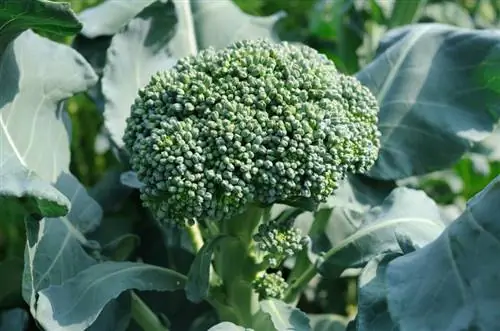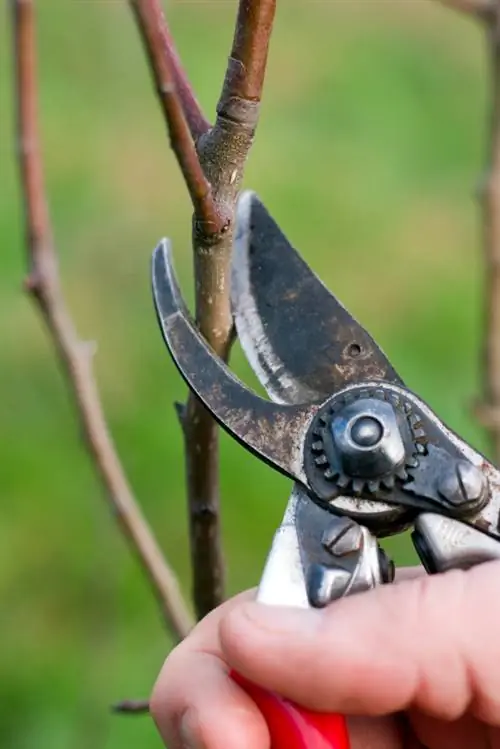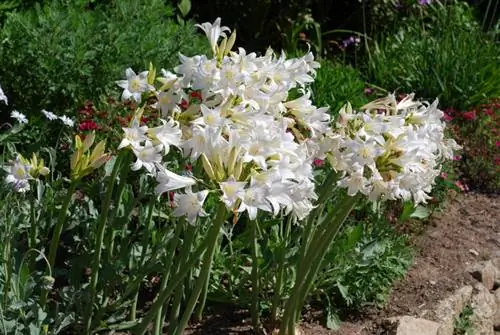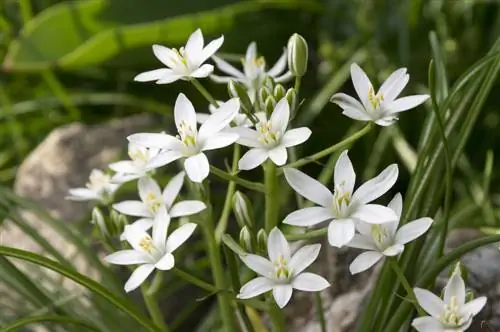- Author admin [email protected].
- Public 2023-12-25 17:45.
- Last modified 2025-01-23 11:22.
With a star magnolia, royal floral splendor finds its way into the garden. So that the queen of the flowering trees feels comfortable with you, it does not require extensive care. Browse through answers to basic questions here and marvel at the frugal, undemanding nature of a Magnolia stellata.
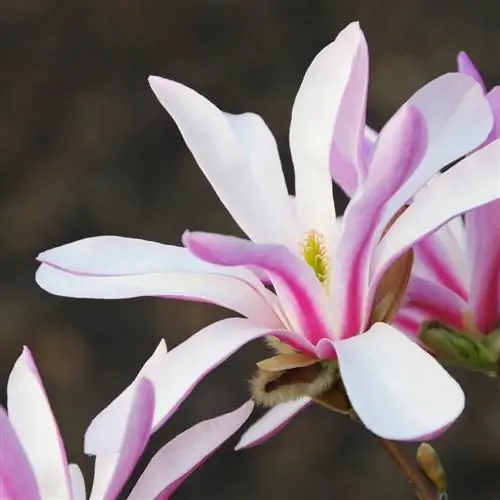
How do you properly care for a star magnolia?
The star magnolia (Magnolia stellata) requires little care and grows best in a sunny to partially shaded location with nutrient-rich, humus-rich and slightly acidic soil. Regular watering, fertilizing in spring and removing dead wood after flowering promote a he althy plant.
Planting star magnolia correctly
In order to plant a young Magnolia stellata professionally, only a few aspects play a role. Early spring has proven to be the best time for planting, when the ground has completely thawed in February/March. Follow these steps to do it correctly:
- Soak the potted young plant in a container with water
- Meanwhile, create a planting pit at the location with a depth of 50-60 cm and a diameter of 100 cm
- Fill a bag with ericaceous soil into the planting hole, add the excavated material and mix
- Plant the potted Magnolia stellata in the middle, press the substrate and water it
- Drive a plant stick into the ground next to the star magnolia to secure the tree to it
It is important to note that the star magnolia does not go deeper into the earth than it was previously. A look at the earth mark shows where the planting depth is limited. A Magnolia stellata planted too deep will not bring you joy.read more
Care tips
Professionally planted in the right location, the care protocol for a Magnolia stellata only contains a few agenda items. The pivotal point is a sufficient water supply, as the shallow-rooted organism quickly thirsts in dry conditions. Ideally, you should use lime-free irrigation water, as the star magnolia prefers a slightly acidic pH value. From March to July, either fertilize organically every 4 weeks with acidic leaf compost (€43.00 on Amazon) or give a mineral-organic long-term fertilizer for ericaceous plants.
Every year after flowering, the dead wood should be removed so that light and air reach all areas of your Magnolia stellata. Pruning should only take place if it is unavoidable. In this case, grab freshly sharpened and disinfected scissors after flowering. Winter protection is only required in the bed in the first year and in the pot.
Loving care protects the Magnolia stellata from diseases such as leaf spot and powdery mildew. In addition, pests such as aphids or whiteflies avoid a vital and he althy star magnolia.
Which location is suitable?
The choice of location contributes significantly to the successful cultivation of a Magnolia stellata. The following criteria should be met:
- Sunny to semi-shady location without blazing midday sun
- Nutritious, humus-rich soil, deep and freshly moist
- Ideally a slightly acidic pH value of 5.5 to 6.8
We recommend giving preference to a sunny northern location over a sun-exposed southern exposure. Thanks to this prudence, early-flowering Magnolia stellata will protect you from the worst effects of late frosts, as the start of flowering will be delayed a little.read more
When is flowering time?
The star magnolia opens its flowers as one of the first ornamental trees in the garden. The flowering period of a Magnolia stellata begins at the beginning of March and extends well into April. If this very early start of flowering is too delicate for you, choose the Royal Star variety. Here the white star blossoms only open from mid-March and delight us until May when the weather is nice.read more
Cut star magnolia correctly
The star magnolia is one of the garden's special treasures because it does not age even after many years. Instead, a Magnolia stellata gains in enchanting beauty over time. The flowering tree achieves this miracle without extensive pruning. Given the slow growth rate, there is rarely a desire to prune anyway. How to properly handle this aspect of care:
- Cut a Magnolia stellata after flowering if necessary
- Short shoots that are too long by a maximum of a third
- Thoroughly thin out the wood every year after flowering
An optimal cut starts just above an outward-facing eye, with the scissors positioned slightly at an angle.read more
Fertilize star magnolia properly
As flowering begins, the need for nutrients increases. To ensure that the Magnolia stellata has enough energy for the lush flowering and subsequent leaf shoots, give the ornamental tree a helping hand with suitable fertilizer. How to do it right:
- Administer a granulated slow-release fertilizer for ericaceous plants in March
- Dose the preparation according to the manufacturer's instructions, work it in with the rake and water
- Alternatively, add mature leaf compost and horn shavings to the tree disc every 4 weeks
- Provide Magnolia stellata in the bucket with liquid fertilizer
The application of fertilizer ends in July at the latest so that the star magnolia can mature before winter.read more
Diseases
Mother Nature has endowed the star magnolia with a robust constitution. When he alth problems arise, fungal infections are usually the culprit. Powdery mildew and downy mildew in particular can cause problems for Magnolia stellata. In addition, the ornamental tree should be checked regularly for symptoms of leaf spot disease. This bacterial infection manifests itself in the form of black spots on leaves and flowers.read more
Propagate star magnolia
The lavish abundance of flowers of a Magnolia stellata, coupled with unobtrusive care requirements, naturally awaken the desire for more specimens. Fortunately, there are several answers to the question about possible methods of propagation. This is how you can grow a star magnolia:
- Lowers
- Cuttings
- Moosen
- Refining
- Sowing
Propagation using a planter is recommended for inexperienced hobby gardeners. To do this, pull a half-woody, he althy shoot to the ground and dig in a central section. While this cutting remains attached to the mother plant, it develops its own root system. Sowing, on the other hand, is the most complex and time-consuming method, as stratification is required and the first flowers only appear after 5-8 years at the earliest.read more
How do I transplant correctly?
You can transplant a star magnolia even after a few years. A suitable time is either a day in March or, better yet, in September/October. In order to make the procedure as stress-free as possible for your Magnolia stellata and to minimize the loss of root mass, the right preparation makes a valuable contribution.
Two weeks before the actual transplanting, cut off the roots all around. Ideally, the diameter corresponds to the height of the flowering bush. Then loosen the root ball with the digging fork and then water thoroughly for 30 minutes. Until you plant the star magnolia in the new location, repeat the watering process 1-2 more times.read more
Star magnolia is not blooming
If a Magnolia stellata refuses to bloom, this is how it expresses its displeasure. It's best to start investigating the cause straight away. For these reasons a star magnolia does not bloom:
- Wrong location: too shady, too chalky, too dry, too wet
- Pruning in autumn destroyed all the buds that had already formed
- After a recent transplant, the Magnolia stellata takes a lot of time until the next flowering
- A star magnolia grown from seeds only blooms for the first time after 5-8 years
- If there is a lack of nutrients, the tree lacks the energy to produce flowers
read more
Brown leaves
If the well-formed, green leaves of a star magnolia turn a sad brown, the ornamental shrub is not doing well. Possible causes include: a fungal infection, leaf spot, an unsuitable location, drought or a lack of nutrients. However, if summer is already coming to an end, this is a completely natural shedding of leaves.read more
The star magnolia as a standard tree
As a standard tree, the Magnolia stellata has an elegant appearance. In this form, the flowering tree is ideal for container cultivation and for small gardens. The star magnolia develops these advantages as a standard tree as long as the growth height is kept within limits. If you choose a height of 60-100 cm, care is uncomplicated as the crown is easy to reach.read more
The most beautiful varieties
- Leonard Messel: an outstanding Magnolia stellata with cup-shaped flowers in white with pink stripes
- Chrysanthemumiflora: the variety impresses with its hard winter shell and distinctive flower shells in delicate pink
- George Henry Kern: no one can escape the magic of the majestic flowers with a diameter of up to 14 cm
- Rosea: sets off decoratively from March onwards with initially pink, later pure white flower stars
- Royal Star: saves its white flowers from late frosts by delaying the start of flowering by 2 weeks
- Rosea Jane Platt: emerged from a Magnolia stellata rosea, the variety heralds spring from the beginning of March


